On July 4, the Cheongchuninmun Nonjangpan, an annual speech competition hosted by the Ministry of Culture's Korean Culture and Information Service (KOCIS) and Arirang TV, brought together youth from around the world at the Daemyung Resort in Yangpyeong-gun County, Gyeonggi-do Province. The competition gave the teams a chance to explore Korean traditions by talking about the nation's intangible heritage items.
The Cheongchuninmun Nonjangpan (청춘인문논장판), or "Exploring Korean Humanities Together,” is a cross-cultural conversation run by KOCIS. Its various sessions and competitions offer an opportunity for non-Korean speakers to explore the humanities and to visit historical sites across Korea.
Under the theme this year of “Rediscovering Korean traditions,” the participating teams brought to the stage the final results of their three months of research and labor.

Team Flame Blossom consists of students from Soon Chun Hyang University. They present ways to globalize nakhwanori, a traditional type of fireworks used by scholars during Joseon times.
Starting in March, KOCIS recruited 30 teams, both online and offline, reaching out to 120 participants who took part in preliminary rounds. Among the participants were as many as 110 non-Korean students from 28 countries. By June, a total of 12 teams advanced to the finals.
The non-Korean finalists came from 19 countries: the U.S., the U.K., Canada, Germany, Saudi Arabia, Congo, Portugal, China, Japan, Russia, the Philippines, Laos, Tanzania, Kyrgyzstan, Uzbekistan, Mongolia, Bulgaria, Brazil and Austria. They were put into teams with Korean students to deliver a presentation on Korea's intangible cultural heritage.
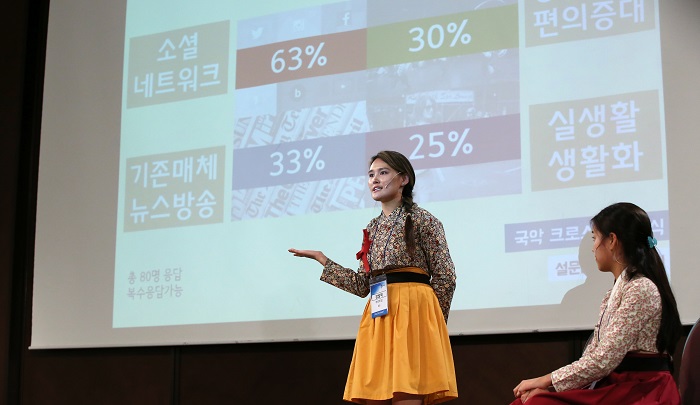
Sumiya Burtujin, a Mongolian student at Kyung Hee University and a member of Team Chapssaltteok, talks about gugak music and gugak crossover music in the Cheongchuninmun Nonjangpan competition.
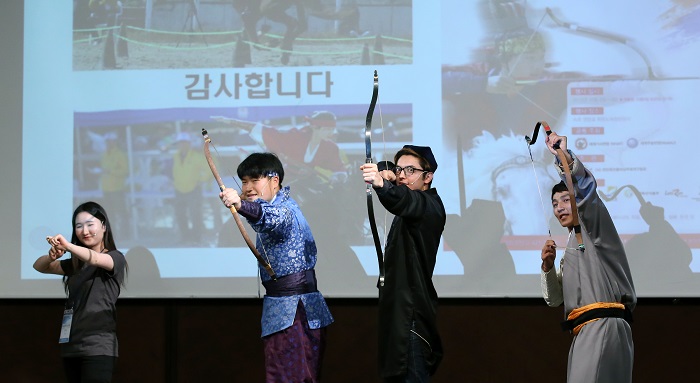
The Saesangae Masangae team (세상에 마상에), consisting of students from Korea, Mongolia and Uzbekistan, pose like archers. The team gave a presentation on traditional Korean horseback martial arts.
A total of 50 finalists grouped into 13 teams gave presentations on a variety of Korean traditions, ranging from traditional fireworks, known as nakhwanori (낙화놀이), Joseon-era seonbi scholars (선비), traditional markets, the globalization of traditional Hanbok attire and through to the "farm stay" program, a type of bed-and-breakfast on a farm. Presentations covered the five traditional colors, obangsaek (오방색), the traditional ganggangsullae dance (강강술래), Korean cuisine and even gugak, a genre of traditional music.
The five-hour competition kicked off in earnest as Team Jiphyeonjeon (집현전), made up of two Korean students and two Brazilian students, performed a skit that highlighted Korean cuisine. This included representative foods, like bibimbap or bulgogi, as well as many kinds of healthy traditional teas, such as green plum tea, jujube tea and ginseng tea.
“Given a chance, I wish I could go back to Brazil and open a Korean restaurant, allowing more Brazilians to taste Korean food,” said Rafael Milliati Ramalho, a 26-year-old member of the team. He is currently studying for a master’s in development and cooperation with North Korea at Chung-Ang University.
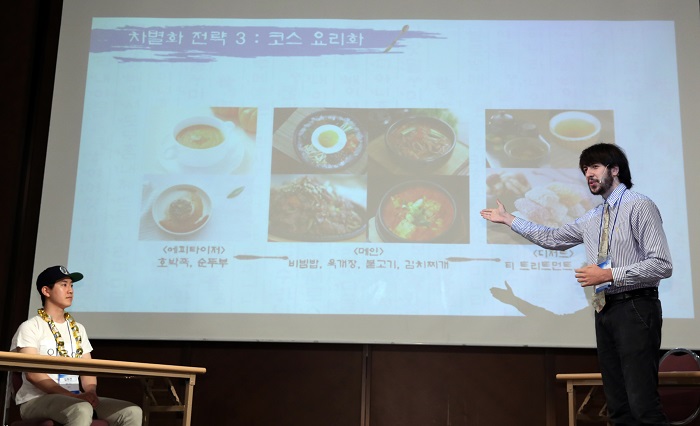
Rafael Milliati Ramalho (right), a Brazilian graduate student at Chung-Ang University, talks about different strategies to promote Korean food around the world.
Another eye-catcher unfolded as a Chinese student and a German student, both dressed in traditional Hanbok dresses, came to the stage. The two were members of the Flame Blossom team and started to perform a skit with two Korean students. They talked about traditional fireworks that date back to Joseon times, known as nakhwanori (낙화놀이).
The group proposed a series of measures that could revive and spread the forgotten pyrotechnic tradition, including having the fireworks displayed during well-known firework festivals and refurbishing transportation and accommodation facilities in regions where the firework tradition remains intact, such as in Muju in Jeollabuk-do Province and in Haman in Gyeongsangnam-do Province.
Team TTelight, consisting of four students from Korea, Russia, Japan and the U.S, summed up the charms of pungmulnori, a genre of percussion-based folk music, with three concepts: diversity, a sense of togetherness and unity.
“I first found pungmulnori to be quite interesting. It’s a play that can be enjoyed with others. That's very intriguing for me,” said Twining Lyndsey, a 25-year-old member of the team who's majoring in human information studies at the Academy of Korean Studies.
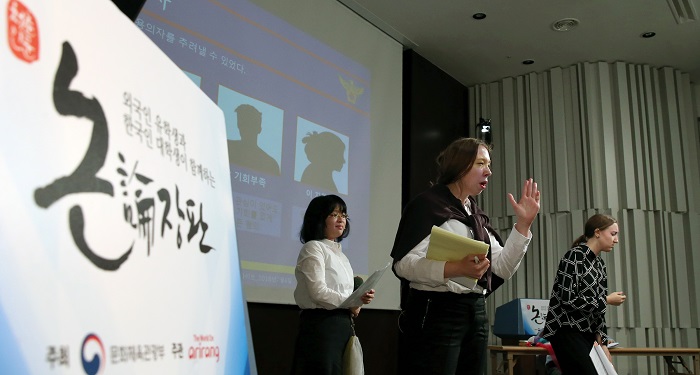
Team Ttelight, consisting of Korean, Russian, U.S. and Japanese college students, performs its skit ‘PungmulnoriMeets the World.’
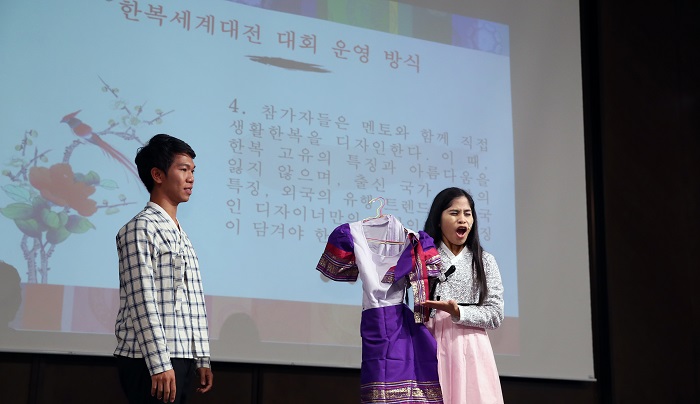
Callanta Maria Lynette (right), a Philippine student at Seoul National University, shows off a modernized Hanbok that embraces Philippine traditions. She is part of the Balahhyeonmi team (발아현미) made up of students from Korea, the Philippines, Bulgaria and Laos.
The Babpuri team (밥푸리), with members from Korea, the U.S., Austria and Britain, shared its hands-on experience from when the members stayed overnight on a farm, a tourism campaign marketed in Korean as a “farm stay” (팜 스테이). The team said, “Staying with a farming family gave us a chance to witness friendliness, generosity and affection first-hand, known as jeong in Korean (정, 情). We really enjoyed it.”
Another team, Balahhyeonmi (발아현미), shed light on modern Hanbok clothing. Tsvetomira Vekova from Bulgaria and Sithiphone Sithoumphalath from Laos, both studying at Seoul National University, said that, “Modernized Hanbok clothes feel more comfortable and less flamboyant than traditional ones, so walking around in modern Hanbok doesn’t attract as many inquisitive eyes on the street. This kind of Hanbok can also go well with normal clothes, we think.” They said that any type of Hanbok that keeps its traditional beauty intact while appealing to both Korean and non-Korean tastes, would be fine for daily wear.
The event wrapped up as the Secrete Move team, made up of students from Korea, Congo, Tanzania and Mongolia, performed the traditional ganggangsullae dance (강강술래). The dance embraces the sentiments and rhythms inherent to the Korean people, and what’s most interesting about this performance is that the group of students added even more dynamic moves and exciting music to the traditional forms. The adaptation was so stirring that it moved all the other participants and audience members to come to the stage and to dance together in unity. Youth from around the world truly globalized Korean traditions.
By Sohn JiAe
Korea.net Staff Writer, reporting from Yangpyeong-gun County, Gyeonggi-do Province
Photos: Jeon Han, Korea.net photographer
jiae5853@korea.kr